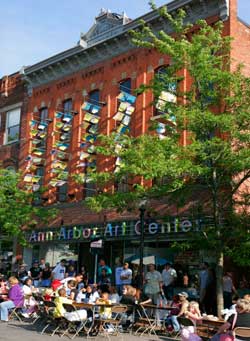There's no consensus in the urban planning profession -- or in public opinion more generally -- about how to handle declining cities like Detroit.
All sorts of solutions have been proposed, ranging from the outlandish (making Detroit a "skyscraper ruins park") to the more widely accepted (converting vacant land into urban agriculture).

But lately Michigan leaders have seized on a strategy that may be the most promising yet: placemaking.
From newspaper columnists to business executives, from the Department of Transportation and Governor Rick Snyder, Wolverines of all stripes seem to be coming to the conclusion that creating vibrant, walkable urban places is perhaps as important to the future of the state as the auto industry was to its past.
Leading this philosophical sea change is a nonprofit group representing the state's incorporated cities and suburbs: the Michigan Municipal League. The League recently published a manifesto for the state's renewal titled "The Economics of Place." (They also started a Streetsblog Network blog by the same name.)
League CEO and Economics of Place author Dan Gilmartin explains, studies have shown that 65 percent of college-educated young people look, first, for an attractive place to live and, second, for a job.
"We’ve spent a lot of time in the last several decades disinvesting in our cities, and all of a sudden that’s what makes you competitive," Gilmartin said.
Creating places that young people find vibrant, exciting and attractive is essential to the state's health, Gilmartin said on the blog:
It started several years ago, in exploring what it will take to return Michigan to greatness. We looked high and low and came to believe with absolute certainty that our future depends on our ability to compete for talent. And as we dug deeper, we found that “talent” (young, college educated, creative people, often entrepreneurs) demands great places. To them, an absolute prerequisite is a vibrant urban center that appeals on an emotional level. They want to live and work where they feel something -- connected, challenged, inspired, excited, free and effectual. These are 21st century communities.
You just don’t get that in a subdivision thirty miles outside the city center, no matter how nicely the lawn is manicured. Don’t get me wrong, many people feel wonderful in that setting too, but for this key demographic, the urban experience is paramount.
The League is taking its "Eight Assets for 21st Century Communities" to struggling places around the state. These eight assets include a wide variety of interventions -- entrepreneurship and multiculturalism, for example -- but sustainable transportation is an important part of the strategy. The League lists its number one asset as walkability, and its number seven is transit.
In tiny former French industrial town Sault Ste Marie on the Upper Peninsula, the League is helping build economic synergy between the town and the local state university. In suburban Detroit's Lathrup Village, it is helping repair the damage done by a nine-lane road that bisects the community.
In a recent column, Detroit Free Press Associate Editor Ron Dzwonkowski praised the group's efforts, wondering how the state may have fared if past generations has taken this approach. He notes, for example, that walkable Ann Arbor, home to the University of Michigan, has weathered the recession better than the rest of the state.
For the four decades that I have been covering public policy debates in Michigan, much of the expelled hot air has been about the best use of taxes and regulations, more or less, to create a climate that will attract investment capital — money that creates jobs. How different Michigan would look today if that debate had been about the best way to attract “human capital” — or to invest in it, so Michigan today had a well-educated 21st-Century work force instead of one that struggles with basic literacy.
Gilmartin agrees. “We don’t lose to the Chicagos, and Seattles, Minneapolises and places like that on taxes and regulations," he said. "We just don’t.” He agrees with Dzwonkowski that creating vibrant urban spaces is far more important in revitalizing Michigan's cities.
From that perspective, there are a few (tempered) rays of hope for Michigan already. Despite the loss of an appalling 25 percent of its population over the last decade, the city of Detroit saw a 59 percent increase in the number of college-educated residents under the age of 35 over the last ten years. News reports from around the country have remarked that despite the city's many problems, it has an offbeat appeal for hundreds of entrepreneurs and artists that are sparking a micro revitalization downtown. NPR even went as far as to wonder if "Detroit is the new Brooklyn."
And local officials have made transportation and livability issues a key part of the plan to revitalize the Motor City. The community has rallied around the revitalizing Midtown neighborhood. And they have made light rail along the Woodward corridor a key piece of their comeback plans.
But that's not to downplay the city's difficulties. Even with the recent educational gains, only 12 percent of Detroit's population holds a bachelor's degree -- a full 15 points lower than the national average.
The low point that Michigan and Detroit now find themselves in, has in many ways, however, been the impetus for this campaign for change. And it's an interesting reversal, now, to see cities taking the lead.
"Things used to come down from feds to the states," Gilmartin said. "Our city leaders kind of challenged us to lead."
"The idea of placemaking -- it’s becoming something we're really able to rally around."





